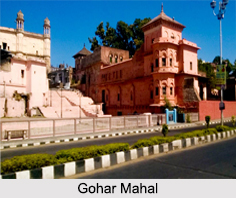 Built in the year 1820 by Qudisiya Begum also known as Gohar Begum, the first woman ruler of Bhopal, the Gohar Mahal is located in the upper bank of the Bhojtal River. This palace is a popular monument of Bhopal and is a popular place of attraction in the city.
Built in the year 1820 by Qudisiya Begum also known as Gohar Begum, the first woman ruler of Bhopal, the Gohar Mahal is located in the upper bank of the Bhojtal River. This palace is a popular monument of Bhopal and is a popular place of attraction in the city.
Architecture of Gohar Mahal
The architecture of the Gohar Mahal is a fusion of the Indo- Islamic architecture and highlights the impact of the Hindu and Islamic culture in the society. The palace is a splendid three-storied structure and spreads over a total area of 650 sq. m. The top floor is enclosed with wooden frame of mansard and the roof is covered with slate tile. The interior of the palace is finished with lath and plaster. There are verandas all around the courtyards along with direct and indirect opening in the structure. The Gohar Mahal is a beautiful monument and is accessible from the main city.
Visiting Information on Gohar Mahal
The nearest railway station is the Bhopal station at a distance of 7.7 km from the Mahal and the Raja Bhoj Airport is the closest at a distance of 11 km.
This article is a stub. You can enrich by adding more information to it. Send your Write Up to content@indianetzone.com



















